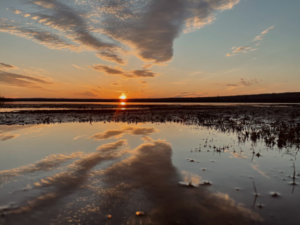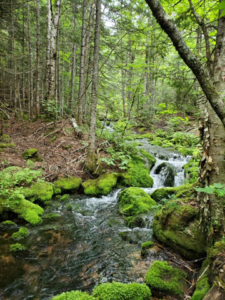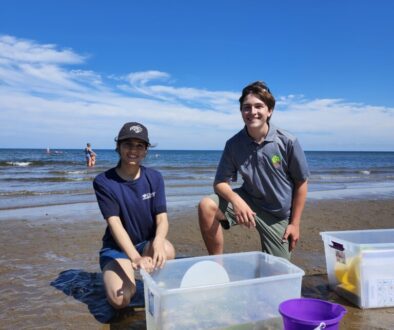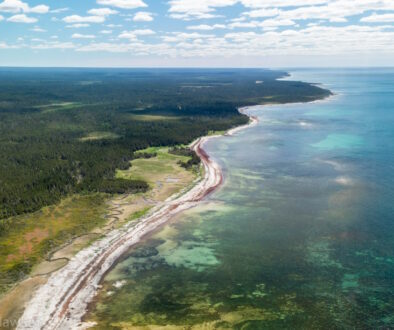Water & the Water Planet
Freshwater 101
One thing many creatures living on earth have in common is the need for freshwater. It is a precious resource that flows through living and non-living things alike. Thanks to modern plumbing, we have instant access to cold and hot fresh water whenever we need it.
We have all likely heard that 70% of the earth’s surface is covered in water. However, this statistic is a bit misleading. It gives the impression that water is an infinite resource, and while some water is abundant, not all water is the same.

Of the water on earth, 97% is salt water in the ocean, and while this supports marine life, salt water is unusable to humans, terrestrial and aquatic life, who need freshwater to survive.
Only approximately 2.5% of the water on earth is freshwater and close to 70% of that freshwater is frozen in glaciers and ice caps, while ~30% is groundwater (water held underground between soil and rocks) and only ~1% is found in rivers, lakes, and wetlands.
These numbers paint a vastly different picture of our “Water Planet” and the abundance and availability of freshwater.
In New Brunswick, we are lucky to have a landscape flowing with rivers and lakes teeming with life. We have roughly 60,000 kilometers of rivers and streams, including our major rivers, the Wolastoq (Saint John River) and the Lustēgoocheechk (Miramichi River). We also have over 2400 lakes and ponds, 53 different species of fish, and many other freshwater animals and plants.
Unfortunately, there are many threats to the freshwater in the province.
Threats to Freshwater in NB
Climate Change

With climate change comes warmer temperatures. New Brunswick is predicted to have a 2-4°C degree increase in summer temperatures and a 2-6°C degree increase in the winter.
This means that in the summer, there will be more evapotranspiration (water evaporating into the air) and decrease the amount of water in rivers and lakes. The number of droughts throughout the province will increase and impact the availability and quality of drinking water.
Similarly, in the winter, it will increase the amount of rain and snow coming down at once, causing major flooding events and increasing erosion in riverbanks.
Paradoxically, while we may have more droughts, we will also experience severe flooding at different times of the year. A solution to droughts and increased flooding is to manage the areas beside the rivers and lakes. Through forest conservation and ecological management, we can ensure that there are wide canopies of trees and shrubs, whose roots can hold the soil in place, and absorb extra water during floods.
Temperature Rise

Along with climate change, not only will the weather become warmer, but so will the temperature of our waters. This is especially concerning because we have many aquatic animals that need cold water to survive. Fish such as the Atlantic Salmon and Brook Trout are not adapted to be in water warmer than 25°C and the number of days the rivers are reaching these temperatures is increasing. The thermal stress on our fish is reaching lethal levels and will impact their survival.
Thermal stress on fish can be reduced by the tree canopy! Mature trees along rivers and lakes provide shade for the water and regulate the temperature. That tree canopy is essential to provide cold water refuges for cold water wildlife.
Species at Risk
Several of New Brunswick’s at-risk species live in freshwater. The Atlantic Salmon, Striped Bass, American Eel, Yellow Lampmussel, Wood Turtle and Parker’s Pipewort are listed under the Species at Risk Act in New Brunswick. Not only are the species integral to the food web but some of the wildlife are also significant to Indigenous Communities for ceremonial and spiritual purposes.
The water of New Brunswick has economic, cultural, ceremonial, and social value. It is a part of our identity and history and is an invaluable resource. Our waters and the creatures within it will soon face many threats and how we act now will determine its survival. The best way we can help our waters is to create protected areas and manage forests ecologically to keep these life-support systems.
Water gives us life and in return, it is our responsibility to protect it.
For more information on what CPAWS NB is doing to protect forests and rivers visit here.
Sources:
https://www.unb.ca/research/institutes/cri/links/inlandfishesnb/index.html
http://www.ecolog.com/daily_images/1004116241-1004117667.pdf
https://www.unb.ca/research/institutes/cri/_resources/pdfs/criday2011/cri_sjr_soe_final.pdf



